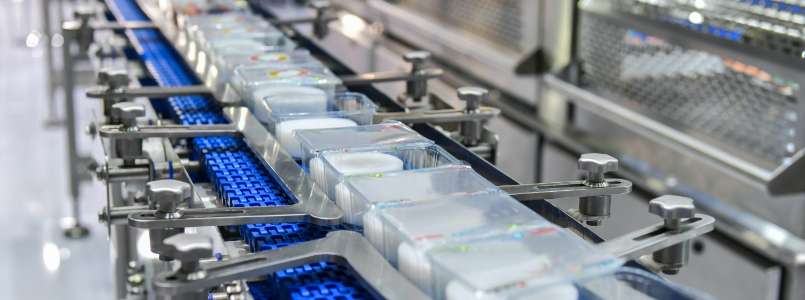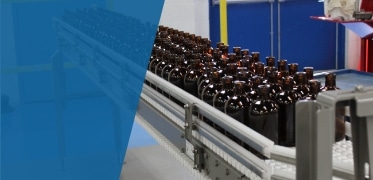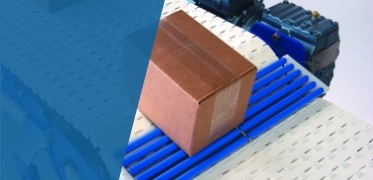6 Common Conveyor Belt Problems
The global conveyor market is expected to reach $10.6 billion by 2025. It’s a big business and one that touches a wide range of operations. Despite the market’s size, even small conveyor belt problems can have a domino effect, creating issues throughout a company’s system. The most common conveyor belt problems include:
Here’s a closer look at each of these common conveyor belt issues.

1. Conveyor Belt Tracking Problems
Conveyor belt tracking issues, often referred to as conveyor belt mistracking, are some of the most common conveyor problems. Belt mistracking occurs when the belt is no longer aligned with the proper path and pulls to one side or the other.
Possible causes of conveyor belt mistracking include belt damage, a crooked splice or off-center loading. There are also other areas of concern, such as:
- A crooked or angled conveyor frame
- Snub rollers that are out of alignment or not tensioned properly
- Dirt or residue on the belt or pulleys, which can force the belt off track
If left undetected, mistracking can cause further belt damage and the shut down of the entire system.
To perform conveyor belt alignment troubleshooting, you should regularly inspect these areas and check for tell-tale signs of mistracking, like frayed edges on the belt. Keep the belt clean, repair damage as it arises and make sure loads are properly centered to avoid major issues and a long shut-down period.
2. Belt Slippage
Conveyor belt slippage is another of the most common conveyor belt problems. Conveyor belts require an exact balance of tension to operate correctly. Having too little or too much tension can cause belt slippage. Besides slippage, improper tension and insufficient traction also can create a strain or stretch on the belts, along with loud squealing and grating noises.
If the belt slips entirely off the pulleys, the result can be serious damage, like a motor failure.
While a range of issues can force a belt to slip, here are the most common causes:
- Cold temperatures, which lower the grip between the pulleys and the belt
- Overweight loads, which strain the belt, causing it to slip
- Pulley issues, which can include a worn head pulley or pulleys that are too smooth
Lagging is often installed on pulleys to create the proper tension, but pulley lagging itself can cause belt slippage if the lagging is improperly implemented.
If you’re wondering how to make a belt stop slipping, the best defense is a good offense. Ensure your belt’s weight range matches the weight of the products you’re moving, and regularly inspect the belt and pulleys for the common causes of belt slippage. Repair these as soon as you find them.
3. Blockages
A conveyor belt line is supposed to transport products smoothly from one location to another. But sharp edges, corners and surfaces can snag an object, causing a pile-up as items begin to gather.
An unexpected accumulation of products can damage items and force the entire system to shut down.
To prevent blockages, regularly inspect your conveyor line for anything that could interfere with product movement and correct it promptly.
4. Carryback
Material carryback is a common conveyor belt problem for material handling systems that carry loose material. Carryback occurs when extra material sticks to the transporting belt, pulleys, idlers and rollers. Humidity and condensation can exacerbate the issue. Material caught like this requires extra cleanup and can lead to overly worn components.
One way to prevent carryback is to install belt cleaners or brushes that dislodge stuck material before it becomes an issue.
5. Material Spillage
It’s not uncommon for material to slide off a conveyor belt, particularly at points where loading and transferring occur. The lost material increases equipment wear and lowers productivity. It also presents a significant safety hazard since loose material can cause employees to slip or fall.
Some spillage is inevitable, but you can prevent excess material spillage by installing impact beds or skirt clamps. Since a poorly aligned conveyor system can increase the likelihood of spillage, it’s helpful to regularly check for and correct alignment issues.
6. Seized Rollers
Another common conveyor belt problem is seized rollers, which lead to sharp edges on the rollers that can:
- Cause the belt to mistrack
- Create a safety hazard
- Damage the objects being transported
- Close down the entire system
Regular inspections can help you identify rollers that are likely to seize, allowing you to replace them before issues arise.
How to Combat Common Conveyor Belt Problems
Common conveyor belt problems cause many issues, ranging from lost production to damaged products to employee injuries and shut-down operations. They often require time-consuming maintenance and repair operations to resolve the problems.
The most comprehensive approach to reducing common conveyor problems is to institute a regular preventive maintenance program. Preventive maintenance is a cost-effective way to catch conveyor problems when they’re easier to address and before they become major issues.
Of course, it’s always important to follow all the best safety advice when working on conveyors, including proper lock-out/tag-out procedures, which ensure that the power is turned off on the equipment you’re repairing.
An Innovative Solution to Common Conveyor Problems With Span Tech
Unlike traditional conveyors, Span Tech builds its systems and Specialty Conveyors with an innovative modular plastic conveyor chain that eliminates the possibility of mistracked belts and other common conveyor problems.
Our modular solution is built with individual interconnecting rows of chain, which can be configured in a wide variety of widths and lengths. Thanks to its collapsibility, our modular chain can create curving, twisting, inclining and declining conveyors.
Trust Span Tech With Your Conveying Needs
We have years of expertise in creating solutions for the most challenging applications to help you avoid common conveyor belt problems. The wide range of custom designs we offer, along with our extensive line of add-ons, means you get the conveyor that’s best suited for your needs. Contact us today to see what Span Tech can do for you.











